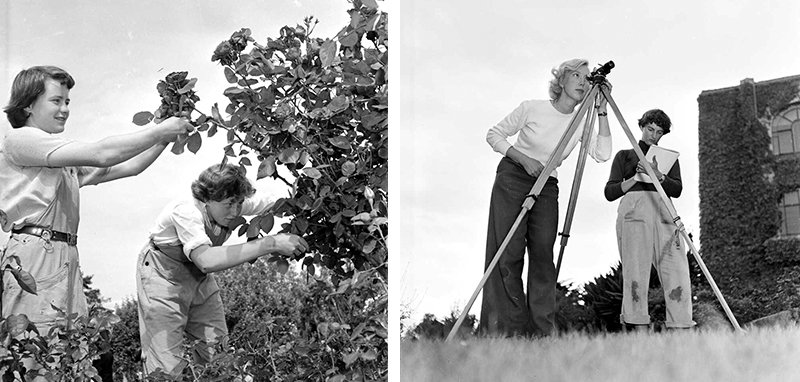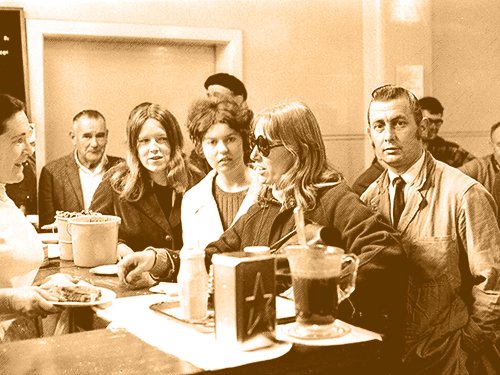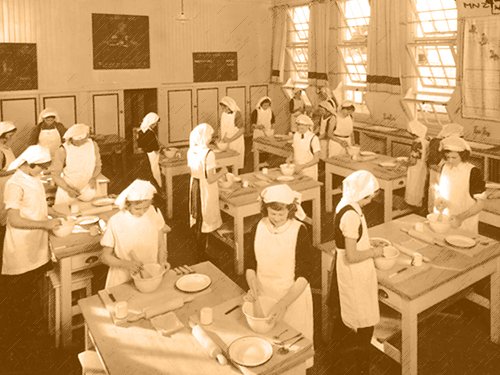But completing a degree at one of the two main engineering schools of Auckland and Canterbury was not the only path women followed to become professional engineers in New Zealand. Some of New Zealand’s first women engineers began their training overseas and registered through the British professional engineering institutions. Other engineering courses at smaller universities or technical institutes became established in the 1960s, providing women with another option for engineering study.
First women engineering graduates and teachers
The first woman to graduate from a New Zealand university with an engineering degree was Leslie Robertson, who completed a BE in electrical engineering at the University of Canterbury in 1965. Other women followed in the years directly after, where they remained a very small minority. Gretchen Kivell studied chemical engineering at the University of Canterbury in the late 1960s. She recalled being one of six women in the engineering school out of a total of 600 students. Reflecting on her time at Canterbury, Gretchen recalled the support and encouragement she received from staff, particularly Professor Miles Kennedy. But looking back she could also see that there was no recognition or understanding of the challenges women faced as a minority, where they were expected to fit into the male culture of the school. Gretchen felt both uncomfortably visible and, in some cases, was completely ignored by male classmates. Her lab partner did not speak to her for their entire year running experiments together.
At the University of Auckland it took a little bit longer before women were a regular sight in engineering classes. From 1948–1969 the University of Auckland Engineering School was based out at Ardmore, south of the city. Students lived in residential halls on site. Liz Godfrey completed an engineering intermediate year at University of Auckland in 1963 as part of a science degree. There were three other women in her class, all doing science degrees. Liz recalled that at that time there was no thought that they or any other women would do engineering, or that they would or could possibly go out to Ardmore.
The first woman to graduate from the University of Auckland Engineering School was Gee Ing Yeow, an international student from Malaysia, who completed her BE in civil engineering in 1970. She would have had to take classes at Ardmore and presumably lived with other women in the accommodation provided for students attending the nearby teachers training college. Many of New Zealand’s early women engineering graduates were international students. The first New Zealand woman to complete an engineering degree at University of Auckland was Gael Knight who graduated BE in Chemical and Materials Engineering in 1973.
Registration with one of the British professional engineering institutions in a particular discipline would also qualify you for engineering work in New Zealand. Pat McCook (Patricia Joan McCook née Boyd, 1928–2022) was born in England but completed her secondary education in New Zealand. She returned to England in 1945 and, after reading an illustrated book about bridges, decided she wanted to be a civil engineer. She found work in the drawing office of a large factory manufacturing transformers and studied engineering part time, taking evening classes. Pat applied to be a student member of the Institution of Civil Engineers but, as she was working for an electrical firm, was refused. However, she was accepted as a student member of the Institution of Electrical Engineers (IEE).
After returning to New Zealand, Pat got a job in the engineers’ office of the Christchurch Tramway Board, where she worked in 1948–1949. She continued to study part time and was the first woman to take engineering classes at the University of Canterbury. Still wanting to be a civil engineer, Pat wrote to the New Zealand representative of the Institute of Civil Engineers to apply for membership. She was refused on the grounds that the work was unsuitable for her and that she would be unlikely to find practical work. She received a similar response from the representative of the Institution of Mechanical Engineers. The IEE’s response – where Pat was already a student member – was more encouraging, and she continued to study, taking evening classes for IEE students at Christchurch Technical College in 1949–1954. Pat passed the IEE entry exams in 1955, making her the first woman in New Zealand to qualify as a professional engineer. After time away from paid work to raise her two children, Pat got a job in 1966 as an electrical engineer at the Consumer Institute’s Test Laboratory in Christchurch. She became a Chartered member of the IEE in 1972 and continued to work at the Consumer Institute’s Test Laboratory until her retirement in 1988.
As the first woman to teach electrical engineering in New Zealand, Dorothy Comley (1927–2002) was another of New Zealand’s pioneers. Dorothy completed her engineering study in England and first began tutoring at the Huddersfield Technical Institute in 1958. After immigrating to New Zealand in 1975 she taught at Wellington Polytech until her retirement in 1992. She recalled that male colleagues and students at first regarded her as a curiosity but this quickly turned to acceptance after proving her competence.
Diversification of engineering courses
New engineering courses in the 1960s provided alternative pathways for women to enter the profession. These courses were often more applied than traditional engineering disciplines, had a greater focus on people and the environment and were well connected with industry. As the courses were new, they had no established masculine student culture, making them more appealing to prospective women students. The courses were also generally smaller, so although women were often still a minority, the gender balance was not as overwhelming.
Massey Agricultural College opened in 1928. From the start, college co-founder and principal, Geoffrey Peren, encouraged women to enrol and the college welcomed its first female students in 1932. Horticulture soon became the most popular programme for women. During WWII, with many men away on active service abroad, women dominated a number of Massey’s courses. In 1944 the college opened a women’s hostel to accommodate the growing number of female students.

Activities at Massey College. Photos: Evening post (Newspaper. 1865–2002): Photographic negatives and prints of the Evening Post newspaper. Ref: 114/408/26-F. Alexander Turnbull Library, Wellington, New Zealand
In 1964, Massey introduced its food technology degree programme. It was a first for the country, and offered women another way to use their mathematics and chemistry skills. Dick and Mary Earle joined the college as teaching staff the following year and built up the faculty’s biotechnology and product development programmes. Dick, a chemical engineer, was active in the Institution of Professional Engineers New Zealand (IPENZ) and served as the Institution’s President in 1988–1989. And Mary, as the first female academic engineer at a New Zealand university, was an important role model for students at Massey and the engineering profession more broadly. In 1993 Mary was awarded Honorary Fellow of IPENZ, the first woman to receive this honour, in recognition of “her innovative approach to technology and her dedication to the advancement of her profession.” Mary and Dick retired from their roles at Massey in 1994 and 1996 respectively.
From 1968, Lincoln Agricultural College opened an engineering faculty. This new programme attracted more women than traditional engineering courses and emphasised water conservation, alternative energy sources, safety and resource management.
Auckland Technical Institute (ATI) also entered the engineering training market in the 1960s. From 1964 ATI offered the country’s first full-time technicians’ course – the New Zealand Certificate in Engineering. By 1973 ATI had a fully developed engineering school.
Conclusion
In the 1960s women began to be a small but visible presence at Canterbury and Auckland engineering schools. New engineering courses established in the 1960s at other tertiary institutions also opened doors for women to complete engineering study.

Changes in the 1970s
The women’s movement of the 1970s pushed for women’s entry into non-traditional careers and campaigned for pay equity and educational opportunities. Engineering schools looked to increase female enrolments.


